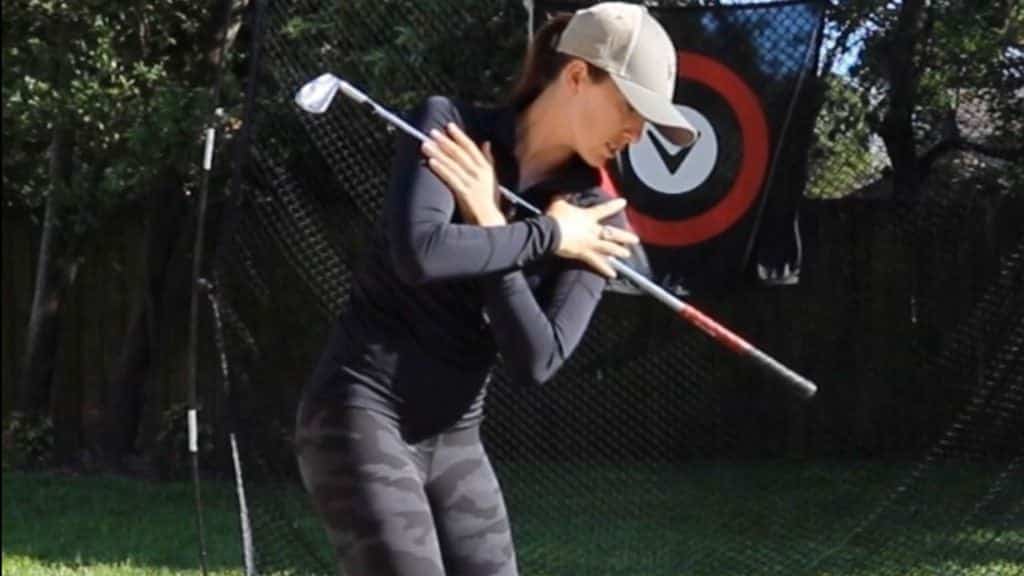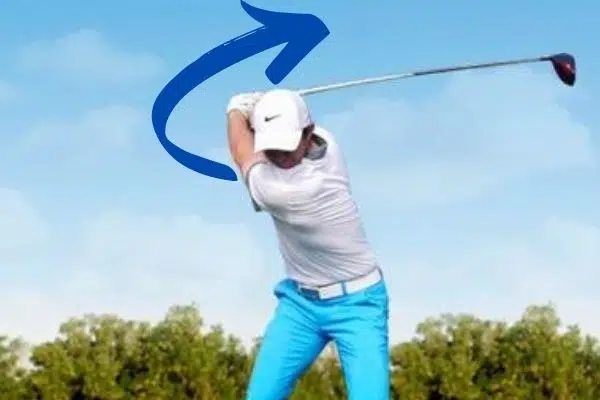When it comes to gaining extra distance off the tee, many amateurs will focus on lengthening their backswing or opening up their hips – but another crucial element to adding more yards to each shot is a correct shoulder turn.
The importance of this move cannot be overstated.
A full turn of the shoulders can have a positive chain reaction throughout the rest of your golf swing – it will keep your chest and arms connected, and you’ll also generate greater width in your backswing.
Not only that, but it’s likely your hips will naturally turn open farther in the takeaway to cater for the coiled energy being stored throughout your core as the result of a bigger shoulder turn.
Simply put, if you want more effortless power, speed and subsequently distance in your golf swing, you need to make a sufficient shoulder turn.
But, the key question is: how much shoulder turn is the correct amount?
In golf, you should turn your shoulders 90 degrees from your address position in order to complete your backswing. If done correctly, the tip of your left shoulder should be pointed at the golf ball at the top of your backswing. This would indicate a ‘full shoulder turn’.
Obviously, this is what you would call a textbook shoulder turn position, but bear in mind not all amateur players will be able to achieve this (possibly due to age, lack of flexibility or past injuries).
In this article, I’ll explain in more detail how you can achieve a complete shoulder turn in line with your physical limitations to get you hitting it longer and straighter consistently.
Table of contents
How should your shoulders turn in the golf swing?
In the golf swing, your lead shoulder should move down and back while staying pointed at, or just inside, your target line during the backswing. In the downswing, your lead shoulder should again begin moving downwards – without standing up and out of your posture – yet in a forward direction along your target line.
Your lead shoulder should not begin travelling upwards until you’ve struck the golf ball.
Moving the shoulders in this manner will help you generate a bigger turn on the way back, and also allow you plenty of room to pivot on the way back through.
When you look at elite golfers from down the line, almost all of them will maintain the shoulder angles they created at set-up right the way through their swing.
By comparison, many amateur players will lose these angles and their shoulders will appear a lot flatter as they move into impact (which can cause either nasty hooks or blocks, and hinder rotation).
This is perfectly demonstrated in the below video from Athletic Motion Golf, which shows that pros move their shoulders – particularly their lead shoulder – in a subtly, but importantly, different way than your average weekend warrior.
So, in summary: in the takeaway, you want your lead shoulder moving down and back; in the downswing, you want it again moving down, but forwards along your target line (keeping them tilted at all times).
As you strike the ball, your shoulder should begin moving upwards – which will actually deliver the clubhead downwards into the impact zone – before exiting to the left as you rotate through.
This sequence of movement will help deliver the club on plane an increase your chances of making solid contact, due to better compression from covering the ball, and hitting a straight shot.
How important is a full shoulder turn in golf?
A full shoulder turn is extremely important for generating effortless power and consistency in your golf swing. As you turn your shoulders, your chest will follow – as will your arms and hips. Not only will a full shoulder turn naturally lengthen your backswing, it will also help you store more coiled energy that can be unleashed in the downswing.
As mentioned earlier, getting your lead shoulder pointed at the ball at the top of your backswing is a great indicator you’ve made the necessary 90-degree, full turn in the takeaway.
Moving all your big body parts – such as your shoulders, chest and core – in unison will also stop any overactive movements of the hands and wrists, or ‘arm swings’, which should improve consistency.
You’ll often see many amateur golfers – I’m talking 30+ handicappers – start their takeaway with their arms only, and the effect this has on their swing is negative in a couple of ways.
Firstly, they’ll usually make very little rotation and stay fixated on the ball, with their hips remaining largely square to the target for most of the swing (rather than opening on the way back, and way through).
And secondly, because they haven’t rotated their shoulders, these amateurs will bend their elbows to try and get the club into what they think is a textbook backswing position (even though arriving at such a position, using this technique, is completely wrong).
By bending their elbows in such a manner, rather than maintaining a straight lead arm, they lose connection with their chest and core, which often results in them flipping the club at the ball to try and generate speed.
Without proper rotation of the shoulders and hips in the takeaway, you will create less power and be less accurate in your swing, which is why making a full shoulder turn is so important.
Do you rotate your shoulders in the golf swing?
Yes. In golf, your shoulders remain tilted on the same angle as they were at set-up while they rotate throughout the takeaway, downswing and impact. Ideally, your shoulders should rotate backwards 90 degrees from their starting position as this will indicate a full turn.
One of the killer moves when it comes to shoulder turn is rotating too flat either on the way back, or way through.
This is particularly common in players who have a tendency to early extend and stand-up out of their posture in their backswing or downswing.
By standing up, the shoulders move from a tilted plane to a flatter plane which will move the club path from neutral (on-plane) to a more rounded plane, causing either big snap hooks or nasty over-the-top slices or blocks depending on your clubface position at the point of contact with the ball.
If you can keep the correct amount of tilt in your shoulders while you rotate through your swing, you will have a far greater chance of keeping your club on-plane and, therefore, produce a straight shot.
How can I improve my shoulder turn in golf?
Improving your shoulder turn in golf requires targeted practice, with specific drills focusing on increasing range of motion but also training you to maintain your shoulder tilt right throughout the swing. If you can master these two components, you will improve your shoulder movement considerably.
As with everything in the game of golf, perfect practice makes perfect – I say this because you will only improve if you are working on the correct drills to enhance your skills.
If you’re spending time on the wrong drills, you’re probably wasting your time.
And, there’s no excuses for not practicing these days, especially given you can groove your swing in the comfort of your own backyard or home via the use of a practice net (see our top picks here).
Best drills for better shoulder turn in golf
There are two drills I’ve found to be excellent for practicing shoulder turn which were recommended to me by my local instructor (who helped me shave six shots off my handicap in the space of just 10 weeks).
Here are the drills.

Drill 1: Club across the chest
Personally, I think there is no better drill than this one when it comes to emulating the correct shoulder tilt and turn in the golf swing.
To perform it, simply:
- Grab a 7-iron and put it across your chest, folding your arms around it
- Stand face-first in front of a wall and take your usual address posture so that your head is lightly touching the surface
- Maintaining contact with the wall with your head, complete your backswing, making sure that the 7-iron does not make contact with the wall at any time
- You shoulder turn is complete once the club is pointed directly at the wall
- With the follow through, again make your turn while ensuring your head remains touching the wall, but avoiding making contact with the surface with your 7-iron
This drill doesn’t involve hitting golf balls – instead, it’s about grooving the correct ‘feels’ when it comes to shoulder tilt.
Keeping your head touching the wall ensures you don’t stand up out of your swing, and avoiding contacting the wall with your 7-iron guarantees your shoulders remain tilted at the correct angle (rather than becoming too flat).
Practice this every night and keep it in mind when you’re hitting balls at the range – you’ll be surprised how much your quality of strike will improve.
Drill 2: Focus on turning your trail shoulder
This is another drill that smashes some of the misconceptions, or feels, about how your shoulders are meant to turn in the golf swing.
When most amateurs think about rotating their shoulders more, as is explained in a helpful YouTube video by 18Strong, they tend to simply pull their lead arm tightly across their body.
What will actually happen in a lot of cases is while the lead arm will begin to move somewhat around the player’s body, their lead shoulder won’t rotate independently of this and will cause their chest, arms and shoulders to get very cramped and bunched together.
The below drill will give you a different feeling to focus on, which will hopefully create more space and room to turn properly back and then through the golf ball.
To perform it, simply:
- Take your address position with a 7-iron
- Instead of focusing on turning your lead shoulder away from the golf ball, concentrate on starting your takeaway by moving your trail shoulder back and away from the golf ball
- Practice this motion a few times while ensuring you retain the correct shoulder tilt and don’t stand up out of your posture
- Once you’ve mimed this a few times, practice hitting some three-quarter shots
By focusing on your trail shoulder turning away from the ball, rather than your lead shoulder, you’ll notice you create far more room between your lead arm and chest by the time you reach the top of your backswing.
Not only this, but you’ll also be able to make a bigger shoulder turn.
Creating space in this manner will stop you getting stuck on the way back to the ball when you begin your downswing, making it easier to keep the club on plane and deliver a square clubface onto the ball.
Final message
While it may seem insignificant for many amateurs, shoulder turn in the golf swing is actually extremely important.
A bad, incomplete shoulder turn will have a negative chain reaction throughout the rest of your swing – and can lead to a short backswing, casting of the club in the downswing and flipping of the hands at impact.
In contrast, a good, complete, full shoulder turn can naturally lengthen your backswing, improve your hip turn and generate effortless power, while also helping keep the club on-plane for straighter shots.
Focus on the drills and concepts above and you’ll see improvement in your shoulder turn in no time.
- TaylorMade SIM2 Max Driver vs M4 Driver: Worth it in 2024? - April 15, 2024
- 3 Ways to Win the Mental Game with the Bridgestone Mindset Golf Ball - March 29, 2024
- TaylorMade SIM Max & SIM2 Max Drivers: Are they Still Relevant in 2024? - March 9, 2024


